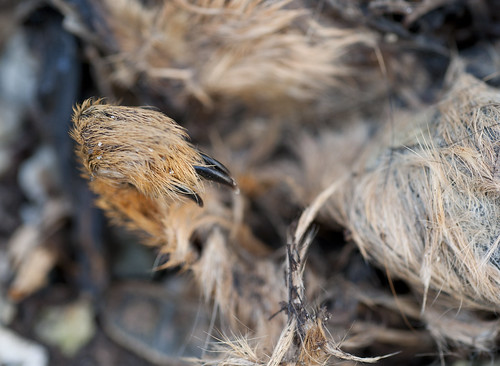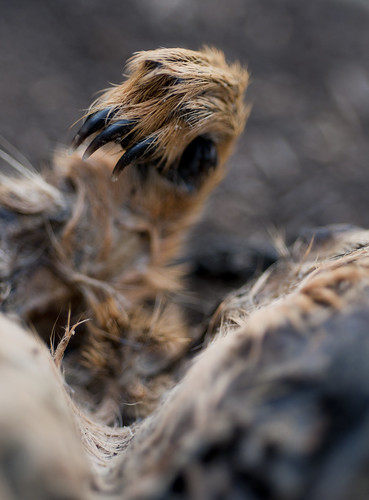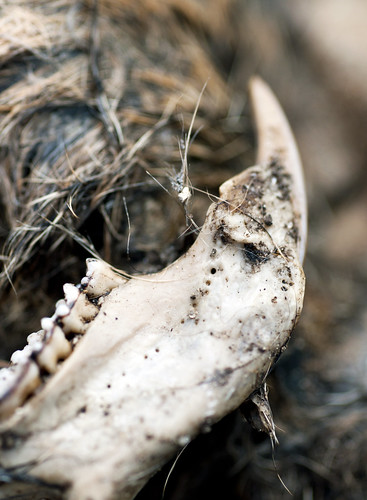What about roadkill, my fallback for when I can't find anything dead in nature? Around here, you don't need to drive far before you start spotting critters in the road, but all the dead animals I've seen in the street have either been a) completely destroyed, b) in a busy and/or dangerous area, or c) both. So -- I've been having a hard time. Not only is this project enjoyable for me, it's something to keep me busy while unemployed. I have been photographing subjects besides dead animals, but it's not as engaging for me.
I knew from the start, though, that this series would be very unpredictable, and the photographs I produce -- and when I can produce them -- depends entirely on the will of nature as well as luck.
All that said, for over a month, I have been keeping track of the fox squirrel killed on our street. For the first two weeks or so, I visited the squirrel quite regularly, and wrote down my observations in a notebook. Here are some of the more memorable snippets:
September 9: "Yellowjacket in squirrel's mouth, many ants in squirrel's eye."
September 13: "Mouth has decayed the most. Mouth/nose area has become a hole, flies laying eggs there."
September 18: "Maggots of all sizes covering the belly/groin of the squirrel, which seems to have burst. There are so many maggots, they have fallen through the carcass and trap, and squirm on the ground. [...] The head of the squirrel is almost unidentifiable, almost could not locate it. The skin (incl. ear) seems to have been pulled through the bars of the trap, but the skull (or what's left of it) has been wedged into a corner of the trap."
September 21: "There was so much movement from the maggots that the squirrel's arm (which had sunk into the body), began to move."
About a week later, as the days got colder and drier, decomposition had slowed, and the body began to mummify. It is interesting to note that early on, the cage was moved on several occasions by an animal; we decided that the culprit was a skunk, looking for maggots to eat! Not only were there flies, ants, and yellowjackets on the carcass, but there were also burying beetles, carrion beetles, and staphylinid beetles.
This afternoon, as the sun sunk lower in the sky, I headed on over to finally photograph the squirrel. Though I had watered it the day before, the body was quite dry, and pulling it out of the trap was relatively easy. I took a series of photographs using the macro lens, and with my close proximity to the subject, I definitely caught a nose-full of dead animal smell.
The first thing to decompose was the squirrel's head. The skull was shattered when the animal was hit by a car, but the lower jaws appear to be intact. They (and the skull fragments) are quite clean and detached from the body; the only other visible bones are the scapulae, protruding through the fur and skin.

This final photograph reminds me a lot of this scene, colors included.
As a whole, what remains of September Fox Squirrel isn't very impressive; a good deal of the body isn't recognizable, and, upon first glance, seems quite foul. However, using the macro lens to get closer helps me to find those beautiful, if not interesting details.
As a whole, what remains of September Fox Squirrel isn't very impressive; a good deal of the body isn't recognizable, and, upon first glance, seems quite foul. However, using the macro lens to get closer helps me to find those beautiful, if not interesting details.






Caroline and I had to move a dead squirrel from her mom's backyard, I've never picked up one before and it was really freaky experience for me. It makes me appreciate your photos even more because I don't have the guts for it.
ReplyDeleteThe macro lens shots are absolutely fantastic.
Thank you for the compliments! Moving a freshly-dead squirrel really is kind of surreal. They're a lot heavier than they look, and it's always awkward carrying a dead animal (how to hold it respectfully without having to touch it too much?). After more than a month of decomposition, this squirrel weighed almost nothing... pretty amazing.
ReplyDelete